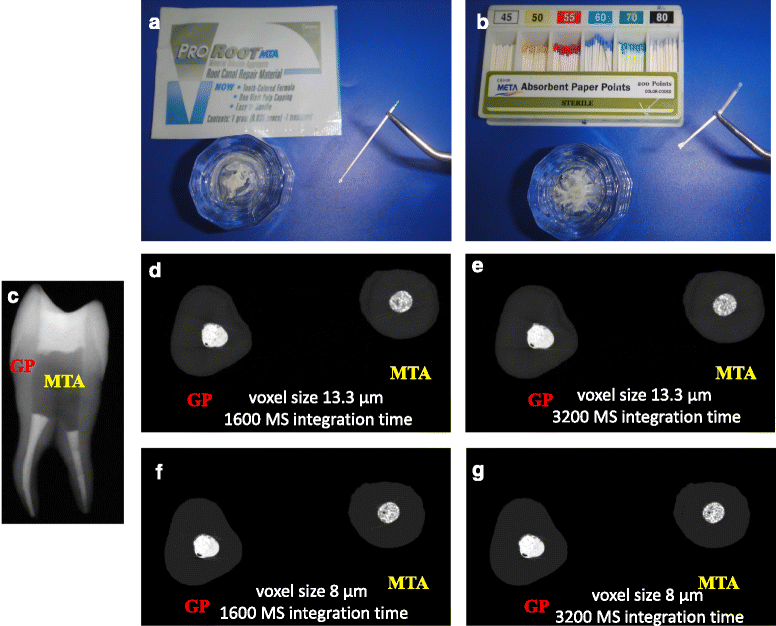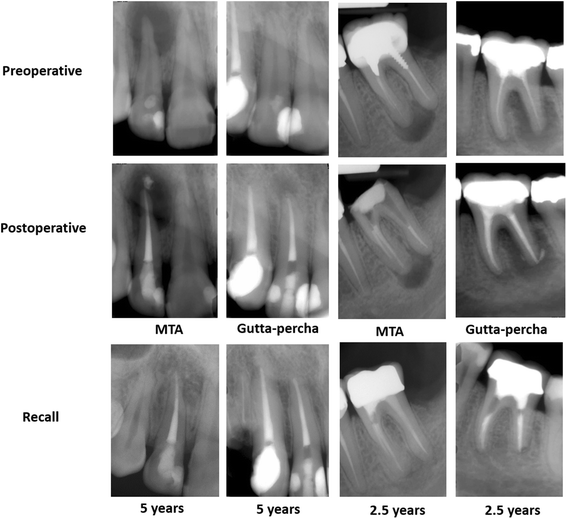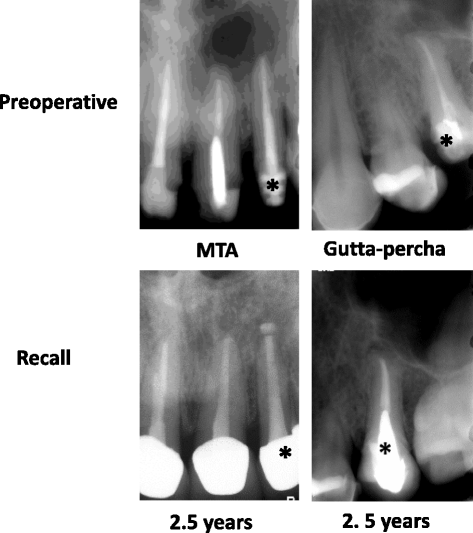Single-visit endodontic treatment of mature teeth with chronic apical abscesses using mineral trioxide aggregate cement: a randomized clinical trial
- PMID: 27553664
- PMCID: PMC4994397
- DOI: 10.1186/s12903-016-0276-y
Single-visit endodontic treatment of mature teeth with chronic apical abscesses using mineral trioxide aggregate cement: a randomized clinical trial
Abstract
Background: Mature teeth with chronic apical abscesses characterized by intermittent discharge of pus through an associated sinus tract. This communication between oral mucosa and periapical inflammation is challenging for the sealing ability of root canal obturation material. Therefore, the study aim was to compare the outcomes of endodontic treatment using mineral trioxide aggregate (MTA) cement to the conventional gutta-percha cone and root canal sealer as an obturation material in mature teeth with chronic apical abscesses.
Methods: Mature teeth with chronic apical abscesses referred to our clinic for root canal treatment between 2010 and 2012 were treated in a single visit and distributed among treatment (T) and control (C) groups using a predetermined randomization block (TCTC). After chemo-mechanical preparation, teeth in group T received MTA cement mixed in a 0.26 water to powder ratio, and teeth group C received gutta-percha and root canal sealer using the warm vertical technique. The treatment outcomes were defined as obturation length, periapical healing, resorption of extruded material, and survival rate at least 2.5 years after treatment. Three endodontists blinded to the type of obturation material documented treatment outcomes. Statistical analysis at P < 0.05 was conducted to measure difference between the groups.
Results: Thirty-six teeth were treated between 2010 and 2012, and 32 teeth were evaluated in 2015. Complete periapical healing was observed in 87.5 % of MTA-treated teeth and 75.0 % of gutta-percha-treated teeth. Adequate obturation length was reported in 50.0 % of MTA-treated and 37.5 % of gutta-percha-treated teeth. Complete resorption of extruded material was evident in 83.3 % MTA-treated teeth and 100.0 % gutta-percha-treated teeth. The survival rate of MTA-treated teeth was 100 % at 3, and 5 years, while the survival rate of gutta-percha-treated teeth was 83.3 % at 3, and 5 years. There was no significant difference between the groups in term of periapical healing, survival rate, obturation length, or resorption of extruded material.
Conclusions: The outcomes of single-visit endodontic treatment of mature teeth with chronic apical abscesses using MTA cement were better, but not statistically significant, compared to conventional treatment.
Trial registration: ISRCTN15285974 . Registered retrospectively 23 June 2015.
Keywords: Mineral trioxide aggregate; Periapical lesion; Root canal treatment; Single visit.
Figures





Similar articles
-
Evaluation of coronal microleakage of mineral trioxide aggregate plug-in teeth with short roots prepared for post placement using bacterial penetration technique.Indian J Dent Res. 2016 May-Jun;27(3):295-9. doi: 10.4103/0970-9290.186233. Indian J Dent Res. 2016. PMID: 27411659
-
Regaining apical patency after obturation with gutta-percha and a sealer containing mineral trioxide aggregate.J Endod. 2014 Apr;40(4):588-90. doi: 10.1016/j.joen.2013.10.020. Epub 2013 Nov 14. J Endod. 2014. PMID: 24666918
-
Comparison of apical sealing and periapical extrusion of the ThermaFil obturation technique with and without MTA as an apical barrier: an in vitro study.Indian J Dent Res. 2011 Sep-Oct;22(5):622-6. doi: 10.4103/0970-9290.93445. Indian J Dent Res. 2011. PMID: 22406702
-
Assessment of Treatment Outcomes with Complete Orthograde Obturation with Bioceramic Materials: A Scoping Review.J Contemp Dent Pract. 2024 Dec 1;25(12):1190-1197. doi: 10.5005/jp-journals-10024-3764. J Contemp Dent Pract. 2024. PMID: 40079999
-
Mineral trioxide aggregate obturation: a review and case series.J Endod. 2009 Jun;35(6):777-90. doi: 10.1016/j.joen.2009.03.006. Epub 2009 Apr 22. J Endod. 2009. PMID: 19482173 Review.
Cited by
-
Comparison of Obturation Quality after MTA Orthograde Filling with Various Obturation Techniques.J Clin Med. 2021 Apr 16;10(8):1719. doi: 10.3390/jcm10081719. J Clin Med. 2021. PMID: 33923426 Free PMC article.
-
Present status and future directions: Hydraulic materials for endodontic use.Int Endod J. 2022 May;55 Suppl 3(Suppl 3):710-777. doi: 10.1111/iej.13709. Epub 2022 Mar 17. Int Endod J. 2022. PMID: 35167119 Free PMC article. Review.
-
Regenerative Therapy Modality for Treatment of True Combined Endodontic-Periodontal Lesions: A Randomized Controlled Clinical Trial.Int J Environ Res Public Health. 2021 Jun 8;18(12):6220. doi: 10.3390/ijerph18126220. Int J Environ Res Public Health. 2021. PMID: 34201328 Free PMC article. Clinical Trial.
-
Nonsurgical endodontic management of mandibular first premolar with incomplete root-end resection.Clin Case Rep. 2020 Nov 29;9(1):437-444. doi: 10.1002/ccr3.3551. eCollection 2021 Jan. Clin Case Rep. 2020. PMID: 33489194 Free PMC article.
-
Comparative Analysis of Fracture Resistance of Endodontic Sealer Types and Filling Methods.Materials (Basel). 2024 Dec 26;18(1):40. doi: 10.3390/ma18010040. Materials (Basel). 2024. PMID: 39795685 Free PMC article.
References
-
- Slutzky-Goldberg I, Tsesis I, Slutzky H, Heling I. Odontogenic sinus tracts: a cohort study. Quintessence Int. 2009;40:13–8. - PubMed
-
- Bhaskar SN. Bone lesions of endodontic origin. Dent Clin North Am. 1967:521–33. - PubMed
-
- Sommer R, Ostrander F, Crowley M. Clinical Endodontics. Philadelphia: W. B. Saunders Co; 1956.
Publication types
MeSH terms
Substances
LinkOut - more resources
Full Text Sources
Other Literature Sources
Medical

